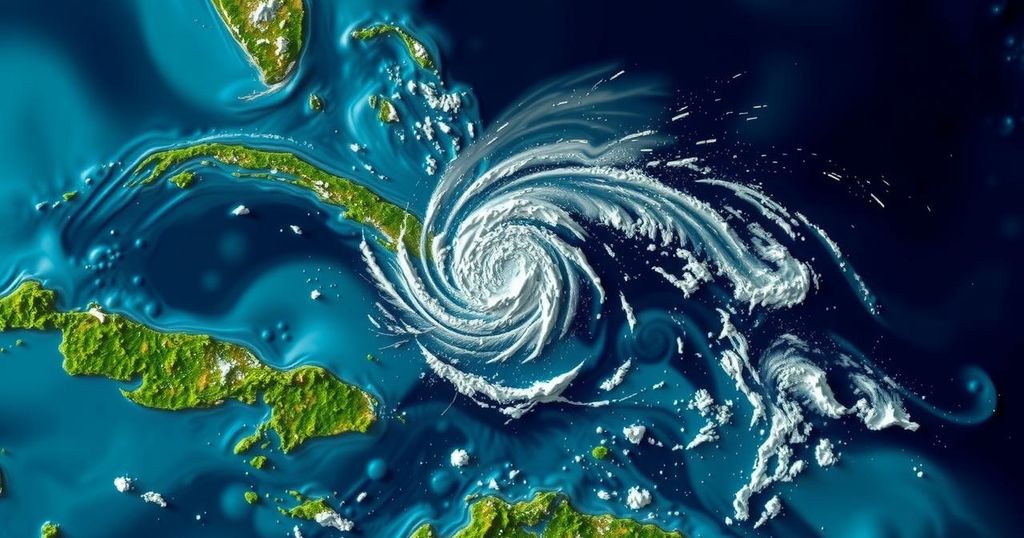Tropical Storm Oscar Approaches the Bahamas After Impacting Cuba

Tropical Storm Oscar approached the Bahamas after making landfall in Cuba as a Category 1 hurricane, resulting in at least six deaths due to heavy rain. Oscar, which was historically noted as the smallest hurricane recorded, demonstrated unpredictability in its intensification and generated significant flooding in Cuba. Meanwhile, NOAA predicts an above-average Atlantic hurricane season.
Tropical Storm Oscar advanced towards the Bahamas on Tuesday after having made landfall in Cuba as a Category 1 hurricane, resulting in at least six fatalities due to severe rainfall. As of Tuesday morning, Oscar was positioned approximately 45 miles (75 kilometers) south-southeast of Long Island in the Bahamas, with wind speeds recorded at 40 mph (65 kph) and a trajectory moving north-northeast at 12 mph (19 kph). According to the National Hurricane Center based in Miami, “Oscar is at best barely a tropical storm at this time.” Forecasts predicted that the storm could deposit up to 5 inches (13 centimeters) of rain in the southeastern Bahamas, with localized areas potentially receiving as much as 8 inches (20 centimeters). Consequently, a tropical storm warning was duly issued for the central and southeastern regions of the Bahamas. In an unprecedented turn, Oscar set a record as the smallest hurricane documented, with a wind field spanning merely about 6 miles (10 kilometers). The storm’s unexpected intensification caught many meteorologists off guard when it made landfall on Grand Inagua Island in the Bahamas on Saturday and again on eastern Cuba late Sunday. Michael Lowry, a hurricane specialist and storm surge expert, remarked, “It’s not often we see a colossal failure in hurricane forecasting,” emphasizing that no predictive models signaled Oscar’s transformation into a hurricane. The storm unleashed at least 15 inches (38 centimeters) of rain on certain areas of eastern Cuba on Monday, raising concerns regarding substantial flooding and potential landslides. The reported deaths occurred in Guantánamo. This disaster unfolded as Cuba continues to grapple with the aftermath of a significant power outage, which recently incited minor protests and led to stern governmental warnings against civil disturbances. Oscar represents the 15th named storm and the 10th hurricane of the current Atlantic hurricane season, which runs from June 1 to November 30. The National Oceanic and Atmospheric Administration (NOAA) has forecasted an above-average Atlantic hurricane season for this year, citing unprecedented ocean temperatures, with projections indicating 17 to 25 named storms and 4 to 7 major hurricanes of Category 3 or higher. Meanwhile, Tropical Storm Kristy was reported over open waters in the Pacific Ocean, located 375 miles (605 kilometers) west-southwest of Acapulco, Mexico, with maximum sustained winds of 50 mph (85 kph) and movement recorded at west-northwest 15 mph (24 kph). Kristy is expected to reach hurricane status by Tuesday evening.
The article discusses Tropical Storm Oscar, which transitioned from a hurricane to a tropical storm while affecting Cuba and heading towards the Bahamas. It illustrates the storm’s unexpected impact, particularly due to its record-setting size and the resultant fatalities and flooding in Cuba. The context of Cuba’s infrastructural struggles following a large-scale power outage adds to the relevance of this weather event within the broader scope of the Atlantic hurricane season, which remains a significant concern for meteorologists and policymakers alike. Additionally, the report includes the NOAA’s forecasts pertaining to storm activity for the current season, highlighting the notable anomalies caused by climate conditions.
In summation, Tropical Storm Oscar has had a considerable impact on the Caribbean, particularly with its unanticipated shift from a hurricane and the resulting fatalities and flooding in Cuba. The event serves as a reminder of the unpredictability of tropical storms and hurricanes, compounded by growing climate change concerns. As the Atlantic hurricane season progresses, the National Oceanic and Atmospheric Administration continues to monitor storm activity, foreseeing an above-average number of named storms and major hurricanes for the remainder of the season.
Original Source: www.washingtontimes.com








